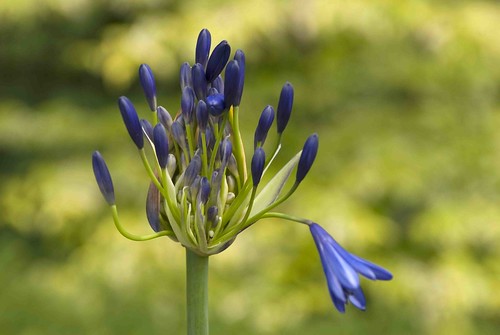Tip of the Week: Spotlight on Agapanthus or African Lily
Posted in Gardening Tips on August 16 2010, by Sonia Uyterhoeven
 |
Sonia Uyterhoeven is Gardener for Public Education. Join her each weekend for home gardening demonstrations on a variety of topics in the Home Gardening Center. |
 Those of you who have visited the Garden this year will have noticed the large containers of brilliant blue agapanthus or African lily that decorate the entrance to the Garden Cafe. (The cultivar we are growing this year is ‘Storm Cloud’.)
Those of you who have visited the Garden this year will have noticed the large containers of brilliant blue agapanthus or African lily that decorate the entrance to the Garden Cafe. (The cultivar we are growing this year is ‘Storm Cloud’.)
Agapanthus is hardy from zones 7 or 8 to zone 10. Some of the many species are evergreen, others deciduous; the deciduous species tend to be hardier and benefit from a heavy winter mulch.
The good news for those of you living outside the hardiness zones is that agapanthus love to grow in a pot and don’t mind crowded quarters. In this part of the country, the easiest thing to do in winter is to store the container of agapanthus in a cool basement or garage, and keep the plants from drying out.
In terms of its classification, agapanthus has had a nomadic existence, wandering from the lily family to the onion family. Some taxonomists are now placing agapanthus in its own family. This migration is understandable. Agapanthus looks like an ornamental onion, and then again, it looks like a lily. Its fleshy roots are rhizomes, and it is often sold as a bulb in catalogs.
This African beauty comes in all sizes. The dwarf varieties hold their globe-shaped flower two feet above their strap-like foliage, while the flowers on taller varieties float up to five feet above the foliage on long, erect stems.
Like ornamental onions, the shape and form of agapanthus, while technically an umbel, fall into the lollipop category, making them wonderful accent or focal specimens.
The color of the flower is heavenly, actually ranging from white to an intense dark blue, with all shades of lavender in between. Agapanthus flowers from midsummer into October, and they love full sun.
Agapanthus, like many garden denizens, thrives in well-drained soil that is rich in organic matter. Fertilize in the spring just as the growth begins. Water consistently throughout the summer for healthy plants, and watch them grow.

